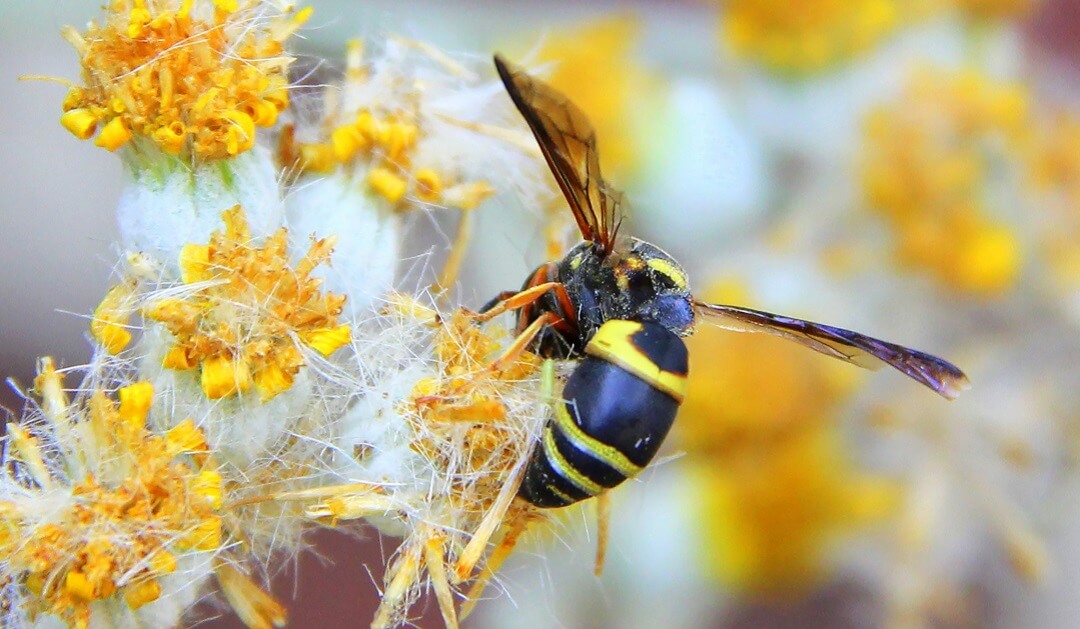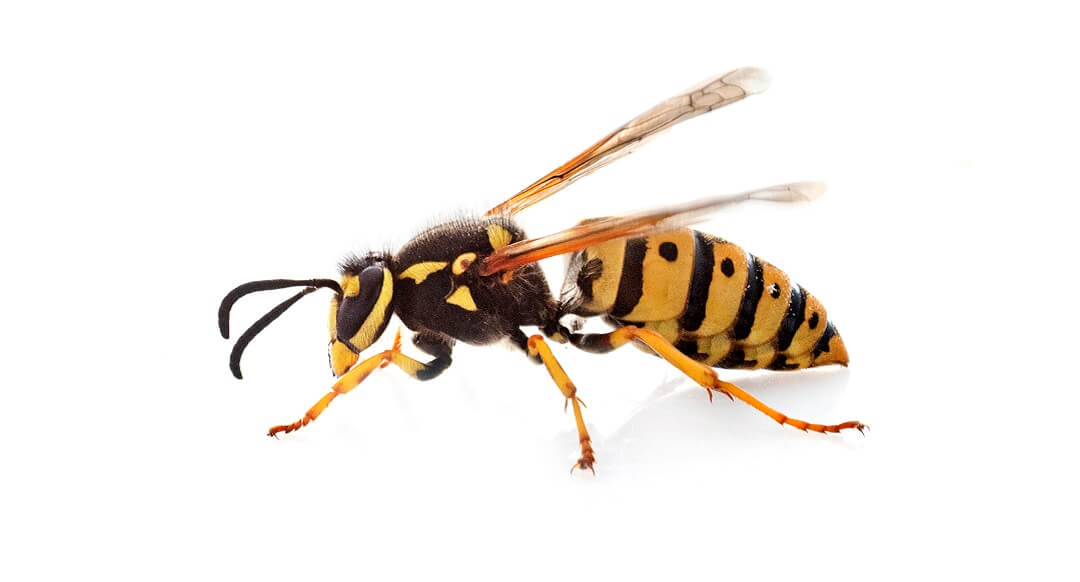
Enjoying time outdoors with family and friends can be a highlight of living in California. However, you aren’t the only that thinks so. Yellowjackets see your outdoor parties and picnics as an open invitation. Unfortunately, these troublesome wasps don’t take kindly to being asked to leave, and their sting can be very dangerous for some. But how do you know which flying insect is a yellowjacket, and what can you do to help keep them away? Here we take a closer look at yellowjacket identification and the different types of yellow jackets.
Key takeaways
- Yellowjackets are social insects that sting and live in large colonies, with the biggest populations in late summer to early spring.
- They have a distinctive segmented body with a narrow waist, elongated wings, and are black and yellow in color.
- Yellowjackets can be found in various locations, including underground, in logs or stumps, cracks in walls, and even inside garbage cans or mailboxes.
- Common species in Southern California include the Western, German, and Aerial yellowjackets.
- Yellowjackets can be dangerous, as they can sting multiple times and cause severe medical complications and reactions, especially for those with bee allergies.
What are yellowjackets?
Yellowjackets are social insects that sting. They live in large colonies that grow in number throughout the summer, hitting their biggest colony populations in the late summer to early spring. While most areas see a die-off of colonies in the winter, California’s warm weather can allow the yellowjackets to survive and grow their colonies for several years, meaning they can be quite large.
What do yellowjackets look like?
Yellowjackets have a distinctive segmented body with a very narrow waist. They have elongated wings and are hairless. They have a pair of antennae and six legs. They are black and yellow in color, with the body sporting a banding pattern. Adults measure between 3/8th to 5/8th of an inch in length. When they are stationary, they rest their wings against their body.
Biology and behavior
As we mentioned, yellowjackets are social insects that live in large colonies. Their colony consists of a queen, drones, and workers who focus on specific tasks designed to help the colony thrive. Workers assume the task of nest expansion, foraging for food, taking care of the queen and new larvae, and defense of the colony. The male drones’ function is to be available to fertilize the queen.
Life cycle
The lifecycle of the yellowjacket includes four stages: egg, larva, pupa, and adult. If the colony dies out over the winter, the queen is the only one to survive. In the spring, the queen emerges from hibernation and begins building a suitable nest that will hold around 45 cells, each of which will house the queen’s eggs.
Once the eggs hatch, the yellowjackets are considered larva. These larvae look like small worms while and use this time to fill with nutrients they will need to grow their legs and wings. At this time, the queen focuses on feeding the larvae a mixture of scavenged food and insects.
Once the larvae enter the pupa stage, they remain in protective pupal cases while their bodies transform to the adult yellowjacket stage. This takes approximately three weeks.
Habitat
Yellowjacket nests can be found just about anywhere. They build their nests underground, in hollow logs or old tree stumps, in cracks and openings between walls, under eaves, and even inside your garbage can or mailbox. Their nests, known as paper nests, are made from a mixture of chewed-up cellulose and saliva. For the colony to grow, worker yellowjackets are continually working on expanding the size of the nest.
Behavior
As we have mentioned, yellowjackets are social insects, with each member playing an important role in supporting the colony. After establishing the new colony and nest in the spring, the queen’s role is to continue laying hundreds to thousands of eggs to grow the colony. The male drones’ only function is to fertilize the queen. Female worker bees do everything necessary to feed the larvae and the entire colony, expand the nest, and protect the colony.

Types of yellowjackets
There are many different species of yellowjackets, with some of the most common species in North America being the Common, Eastern, Western, and German. However, in Southern California, the most common yellowjackets include the Western, the German, and the Aerial Yellowjacket.
Western yellowjacket
The Western Yellowjacket, Vespula pennsylvanica, is native to Southern California and is the most widespread yellowjacket in our area. These yellowjackets are ground-nesters, building their colonies under sidewalks or porch staircases. However, they will also look at foundational cracks close to the ground.
German yellowjacket
The German Yellowjacket, Vespula germanica, established in the Pacific Northwest in the 1980s and slowly spread down the coast, reaching Southern California in 1991. The German yellowjacket is an urban pest that likes to build nests in homes and other structures.
Aerial yellowjacket
The Aerial yellowjacket, Dolichovespula arenaria, is found closer to Southern California beach areas. These are mostly black with thin yellow lines. They make their nests in trees, tall bushes, or under the eaves of your home.
Are yellowjackets dangerous?
Yellowjackets are not aggressive unless they are threatened or provoked. Only the female workers can sting, but, unlike bees, yellowjackets do not lose their stinger when they sting, so they can quickly sting a person repeatedly. In addition, when threatened, they will often bite before stinging, grabbing hold of your skin with their mouth while injecting their stinger multiple times. When they inject their stinger, venomous fluid transfers into the skin. These multiple stings can cause severe medical complications and reactions for those with bee allergies.
In addition, if you swat or kill a yellowjacket, be prepared for war! When a yellowjacket is killed, they release a pheromone that signals the rest of the colony of their death, and the other members will come to avenge their death.
Prevention tips
With Southern California providing a wonderful environment for yellowjackets, how do you prevent them from taking over your yard or from stinging you when you are out enjoying the day?
- Avoidance is best: Yellowjackets are not aggressive in nature and will only sting when provoked. While instinct will tell you to swat them away, you are better to avoid their existence.
- Invest in yellowjacket traps: Simple, yellowjacket traps are available at your local hardware store. These lure traps attract yellowjackets and trap them within the container.
- Repellants: While normal insect repellants won’t deter yellowjackets, a bucket filled with a gallon of water and six ounces of ammonia creates a repellant that you can use to wipe down outdoor tables and trashcans that will repel these pests.
- Residential pest control: While you can opt to try and spray yellowjacket nests and remove them yourself, this can prove to be a dangerous adventure. Choosing a specially trained expert in yellowjacket removal can ensure the pests will be gone, and you won’t be covered in stings and welts.
Keeping your home and yard yellowjacket-free
You don’t have to spend this summer running from yellowjackets or bringing your picnic indoors because they have taken over the yard. The team at Insight Pest Management is experienced in yellowjacket control and prevention and will work with you to eliminate any nests and help ensure you are no longer leaving out the welcome mat for these pests. To learn more, schedule a FREE evaluation online today.

